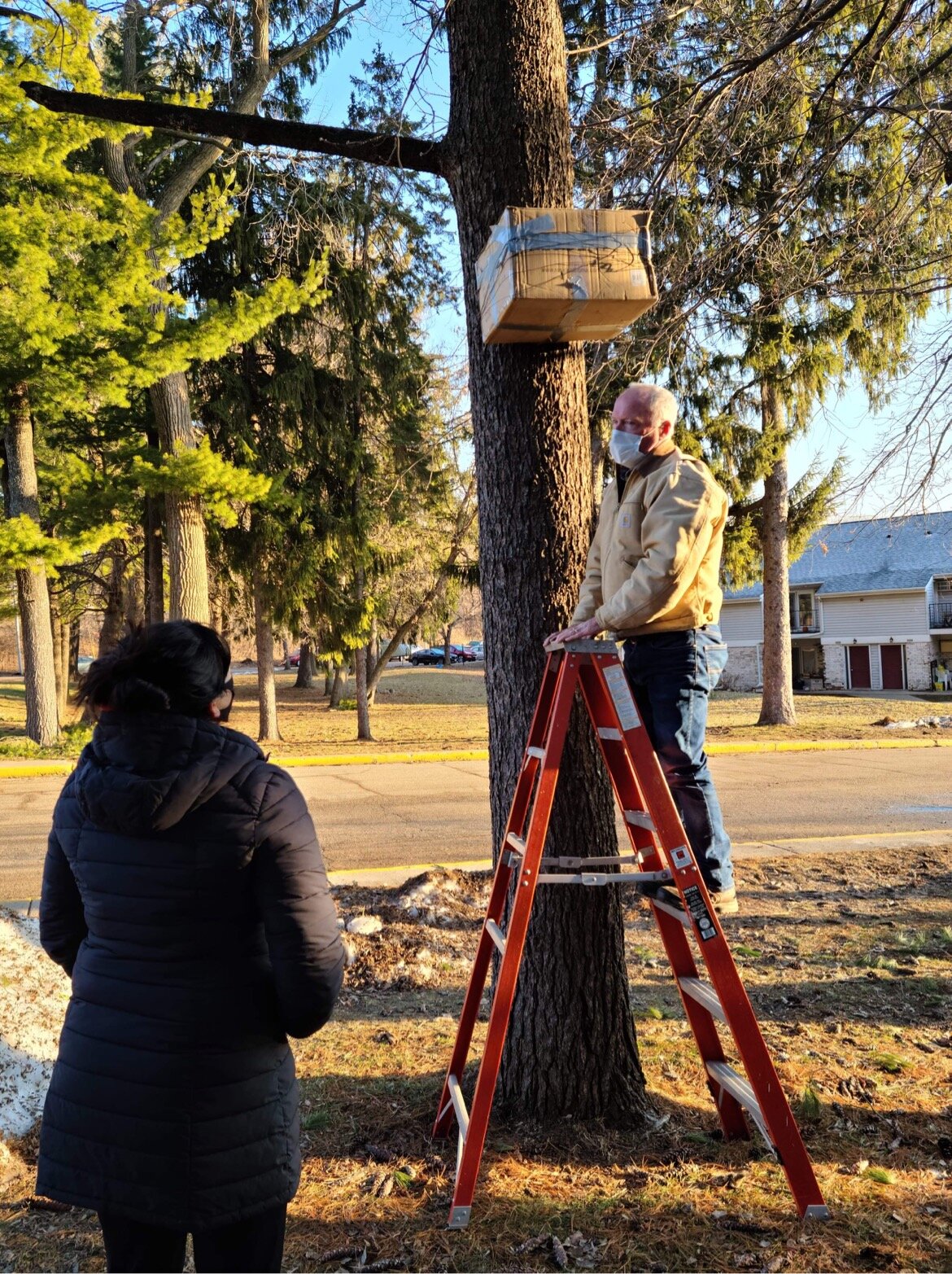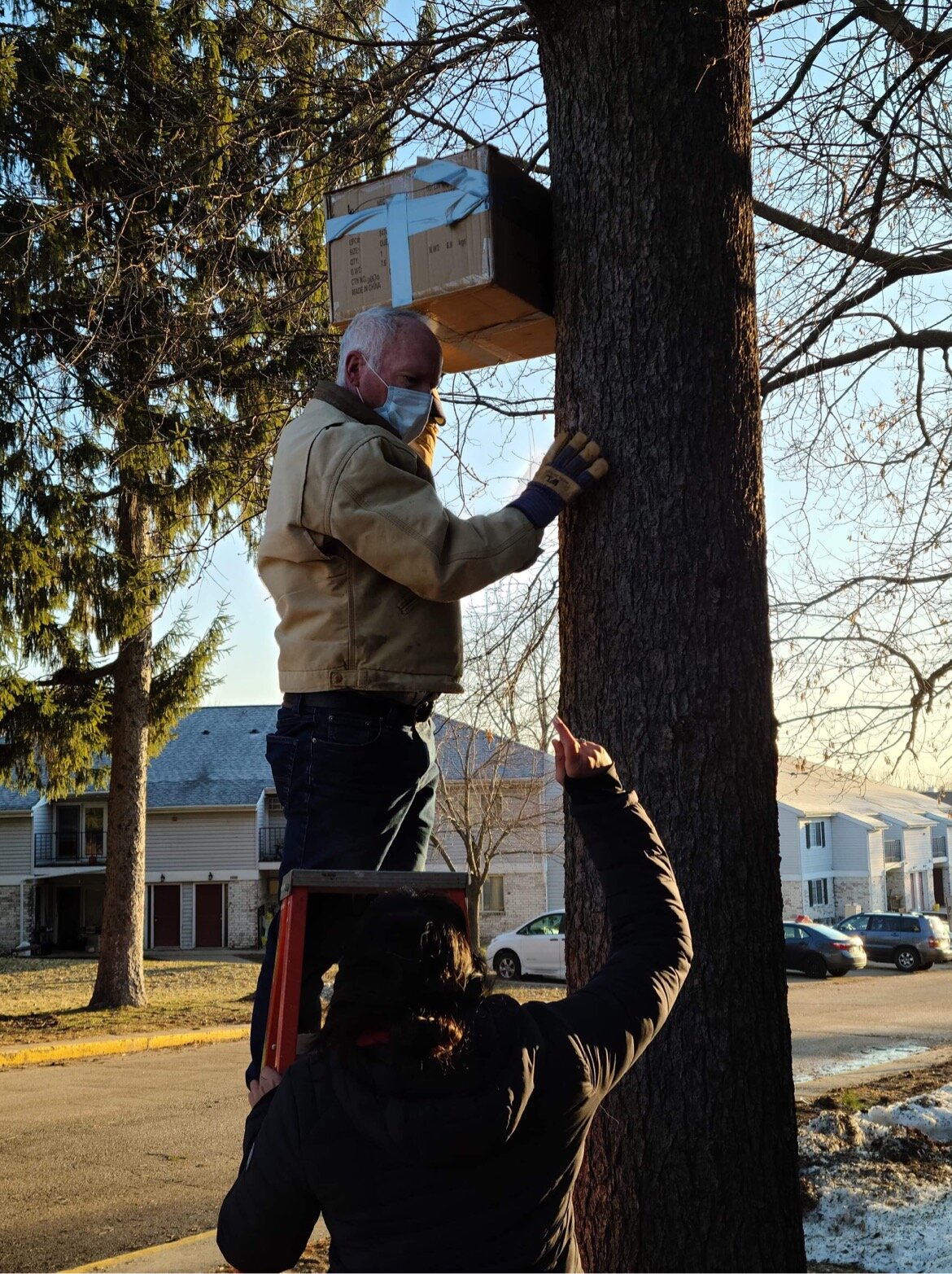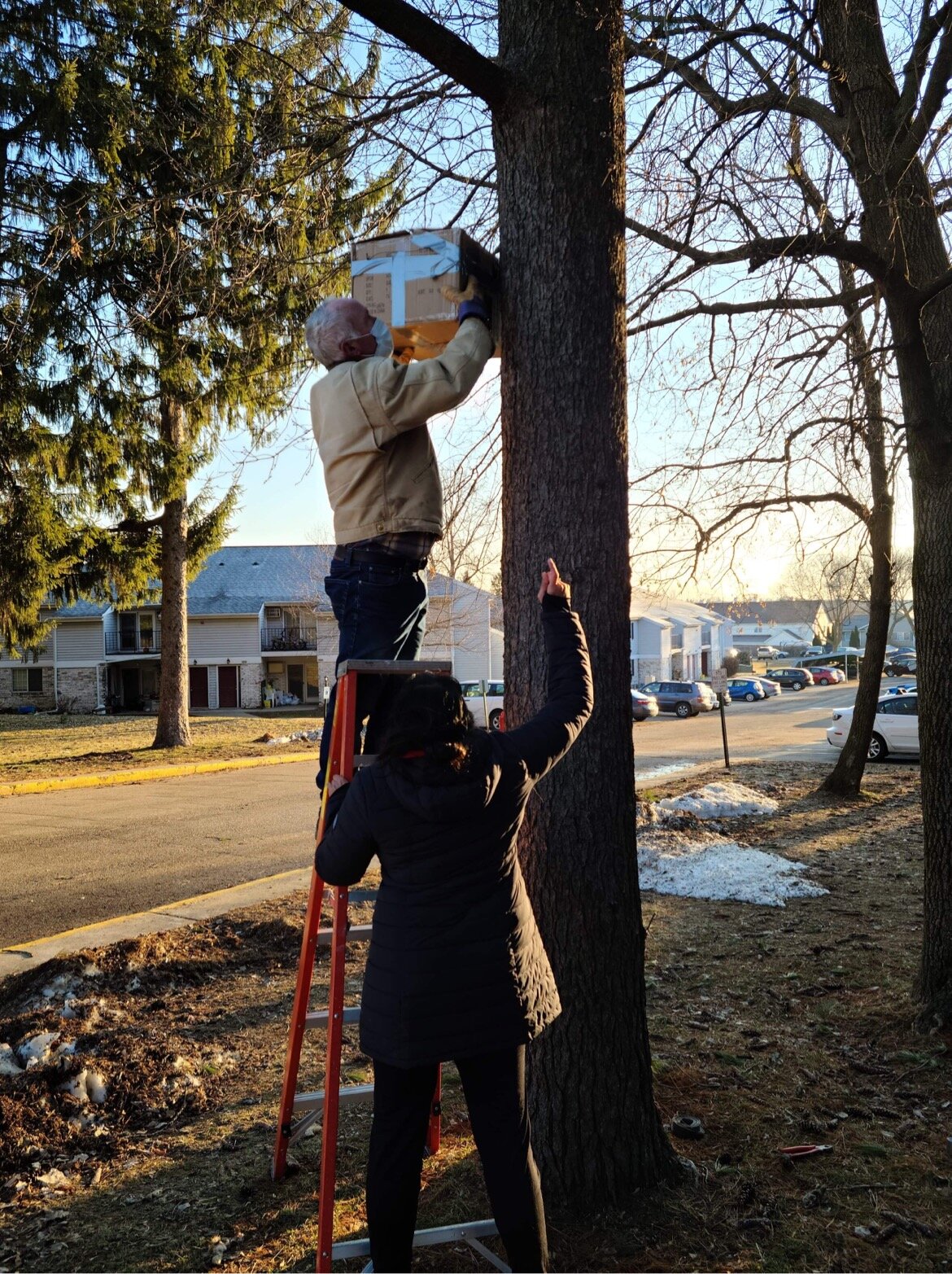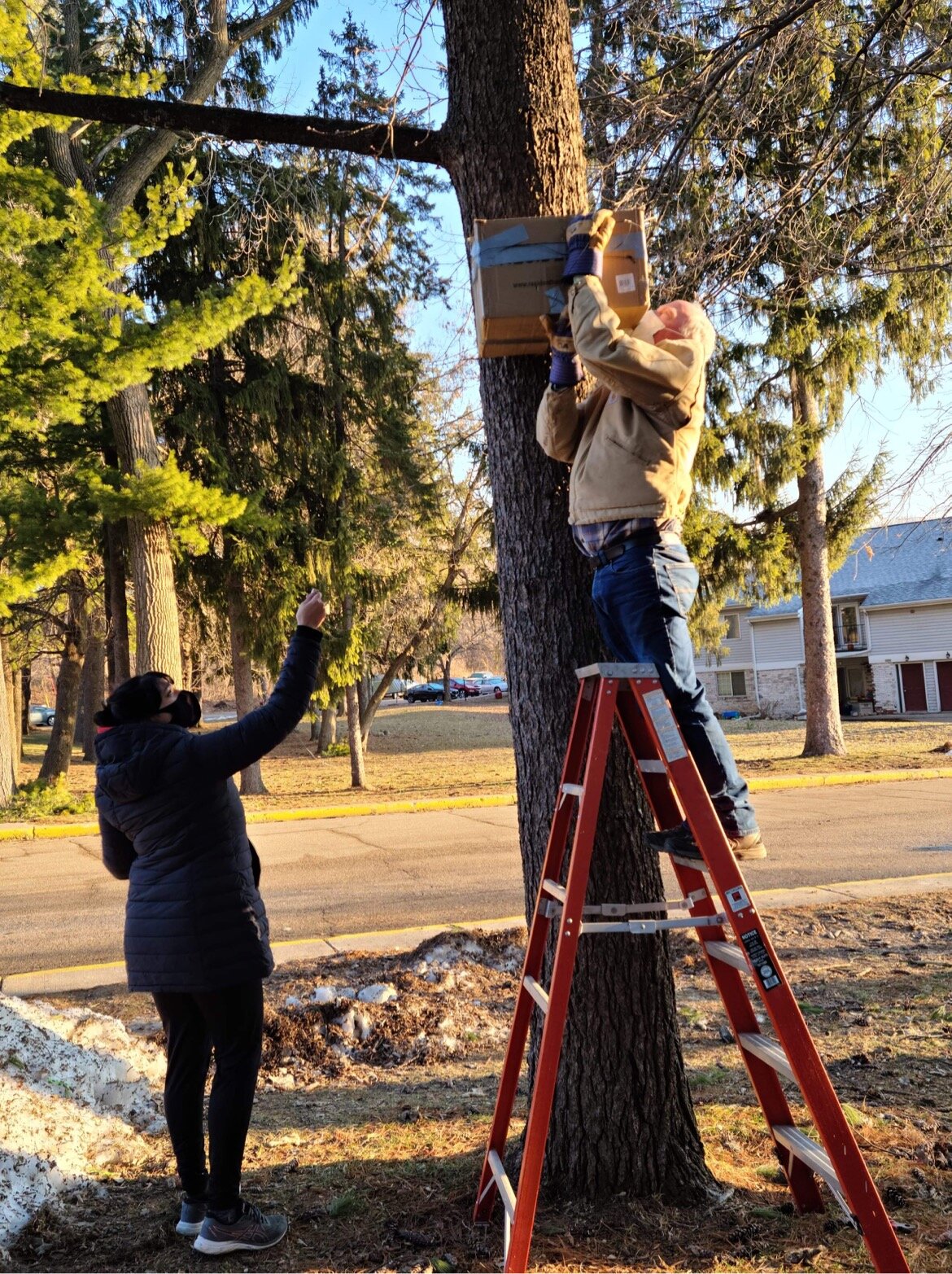Think back to the snow-covered quiet of mid-winter… did you hear the “hoo-h’HOO-hoo-hoo” of Great Horned Owls calling back and forth? And while the coldness of winter might prompt humans to wonder how animals can survive sub-zero temperatures in Wisconsin, Great Horned Owls are doing more than surviving: They’re nesting!
Big eyes on a fluffy head peek out of a Great Horned Owl nest. Photo by Andy Reago & Chrissy McClarren
These owls begin their nesting season in December in Wisconsin, to allow for their young to hatch, grow, and fledge before there’s too much competition from other raptors. So now in March, if you’re lucky, you might see the fuzzy heads of little owlets popping out of a Great Horned Owl nest.
One such fuzzy head did more than pop out of a nest, it fell. Here is a story of an unlucky owlet who fell from a nest but was lucky to have some knowledgeable humans lend a helping hand.
Please keep in mind that this story involves an owl that was rescued and cared for by trained individuals.
Anyone who finds a chick that has fallen out of a nest should refer to this page to determine what to do, and minimize interaction with the bird to avoid excessive stress.
Saving an Owlet
Photo by Kristi Scoville
On March 11, 2021 around 5pm, Cassie Wunderlin was walking her dogs when she noticed a white-fluffy object, surrounded by rabbit limbs and owl pellets, at the base of a tall pine tree. After closer inspection, she realized it was a baby owl! She noticed that the owlet seemed to be shaking and described a commotion in the trees. The owlet likely fell from its nest as a result of the strong winds that day, gusting at 30 MPH.
Following her discovery, Cassie tried to find help. She called the police, DNR, Dane County Humane Society, and a few other locations, but was unable to reach anyone. At the same time, other neighbors were also searching for options. Through the power of networking on Facebook, I learned about the situation and offered to come help. As a former wildlife rehabber, veterinary assistant, and volunteer with Madison Audubon’s Kestrel Nest Box Monitoring Program, I had been involved in similar situations with other wildlife in the past. As I headed over, I sent out several messages. I suggested Cassie and her girlfriend, Kristi Scoville, place the owlet in the small plastic tote they had lined with a towel. I also reached out to Brand Smith, Madison Audubon’s Kestrel program coordinator, for additional feedback on the situation.
Upon arriving at the site at 7pm, my boyfriend, Max Stillions, and I were greeted by Cassie and Kristi. They showed us the owlet huddled at the base of the tree and we began unloading the car: a cardboard box, cedar wood shavings, gloves, and an old towel. There were several other neighbors milling around but everybody was keeping a safe distance from the owlet—roughly 20-30 feet. I put gloves on and slowly approached the owlet keeping in mind the risk of the parents swooping down. The owlet reacted to my movements by snapping its beak and puffing out its body to seem larger and more intimidating. Gently, I scooped the owlet up in the towel and performed a quick inspection (please do not attempt this without training; see “Important things to note” section below).
A new bed for the night. Photo by Nandita Chittajallu
The owlet did not appear to have any bodily injury and was alert and active. Since many of the neighbors walk their dogs in this area, it wasn’t safe to leave it on the ground. I placed it in the cardboard box filled with wood shavings and then chatted with the neighbors about next steps. All of them had pets and could not provide a quiet, indoor environment for the owl so I offered to keep it at my house for the night.
An hour later, Max and I were standing in our screened in porch processing the quick succession of events that had unfolded and left us with an owlet in our house. Our porch was the perfect location to house the little one. It was quiet, dark, and isolated from the rest of the house so the owlet would not be disturbed the by the rest of our pets. We knew it was critical to ensure that the owlet retained body heat so we placed a blanket both above and below the box to ensure it was well insulated. We did not provide any food or water for the owlet per wildlife rehab center guidelines. Since it was stable, we left it alone for the rest of the night so as not to cause it additional stress. At this point, I touched base with Brand and Kristi regarding meeting in the morning to set up a makeshift nest for the owlet. The goal being for it to remain in the wild where its parents would continue to care for it.
Bright and early on the morning of March 12, Brand, Kristi, and I met at the base of the pine tree and craned our necks as we searched for the nest. We wanted to confirm that this was the tree we should place the makeshift nest in. Once confirmed, we used wire to attach the cardboard box with the owlet in it to the tree. We knew this was a temporary solution until more supplies could be obtained but wanted to return it to the wild, and its parents, as soon as possible since it was healthy.
Photos above by Nandita Chittajallu and Kristi Scoville
Brand spent the rest of that morning working to figure out a sturdier, more permanent solution. He consulted with Mark Martin and Sue Foote-Martin, Madison Audubon’s Goose Pond Sanctuary resident managers and bird experts. Per their recommendation, he acquired a bushel basket and adorned it with foliage to create a more naturalistic appearance and make it less obvious to street traffic.
Bushel and a ladder. Photo by Brand Smith
That afternoon, I arrived at the pine tree to meet Brand and set up the bushel basket. As I approached I noticed some neighbors clustering by the tree—still maintaining a distance of roughly 20-30 feet. I followed their gaze and realized the cardboard box had not been able to withstand the repeated 30 MPH winds. It had fallen, returning the owlet once more to the ground. I collected the owlet, placed it in the cardboard box again, and moved it to safety away from the road.
Shortly after this, Brand arrived, armed with a taller ladder, safety helmet and extra help: Doug and Sarah Belt. Together, we were able to place the bushel basket securely between the two lowest limbs of the nest tree. Once the sturdiness of the nest had been confirmed, the owlet was placed in the “nest,” along with several of the rabbit parts that had been strewn on the ground.
Photos above by Nandita Chittajallu
To ensure everything was set up correctly, Brand reached out once more to Mark and Sue and shared pictures of the nest. Upon inspection of the pictures, they realized that the shavings in the nest needed to be changed as they were cedar shavings. They shared that cedar shavings can result in respiratory problems in birds and recommended switching to a different material (see “Important things to note” section below). Neither Brand nor I were able to meet again that evening to make the changes so Brand made plans to go the next day.
That evening, Cassie and Kristi sat in their apartment wondering about the owlet’s fate. As it got later, they began to hear the sounds of the adult owls hooting and the owlets squawking in response as they clamored for food. They shared this with me and the three of us sat in our respective homes crossing our fingers that the calls were from the rescued owlet and that it would be fed that night.
On Saturday, March 12, Brand and Doug returned to the nest to switch out the cedar shavings for pine shavings. When they did so, they discovered fresh food left in the nest. The parents had found and started feeding the rescued owlet! To avoid disturbing the owlet and to provide it with the best chance at success, we will not be returning to the makeshift nest until after the owlet has fledged. Even though I may never see the little one again, I know any time I hear a great horned owl’s call, I’ll be brought back to the magic of this experience and the beauty of how a community banded together to ensure the survival of this owlet.
Written by Nandita Chittajallu
A couple of important things to note:
First, owl parents will often, but not always feed the young on the ground. It is often very dangerous to try to rescue a young owl of any species as the parents will sometimes attack anyone or anything that attempts to "harm" or rescue their young.
If it is necessary to capture the owl, use very heavy leather gloves, a hard hat or helmet and one or two heavy jackets before you try to pick up the young, and it is helpful to have someone with you. Owls with their sharp talons can do great harm to the person who is trying to do good work. For example, Mark Martin was once attacked by an adult great horned owl while trying to assist at a nest site. He had eight puncture holes from talons in his back even though he was wearing a heavy coat.
Second, The toxic effect of cedar shavings on all birds and animals (including hamsters, guinea pigs and birds) is well known in the pet industry and the scientific community. However, you still see pet shops selling and using cedar shavings for bedding because the strong cedar oil smell can help keep odors down. The cedar oils are concentrated in the shavings, unlike in cedar boards that are used in constructing nest boxes. The shavings cause respiratory problems among other issues. To avoid problems, use aspen or pine shavings as bedding or in nest boxes. The concentrated oil problem is also found in redwood shavings so those must also be avoided. In addition, never use treated lumber for bird/animal housing and you will feel good about putting nest boxes out for wildlife.
This amazing story is a wonderful example of how community working together—with the safety and wellbeing of the birds at the forefront—can successfully save a bird. Thank you to everyone involved for making this happen, and to all of the onlookers who respectfully gave the owlet its space!
Written together by Nandita Chittajallu, Brenna Marsicek, Mark Martin, Sue Foote-Martin, and Brand Smith

















